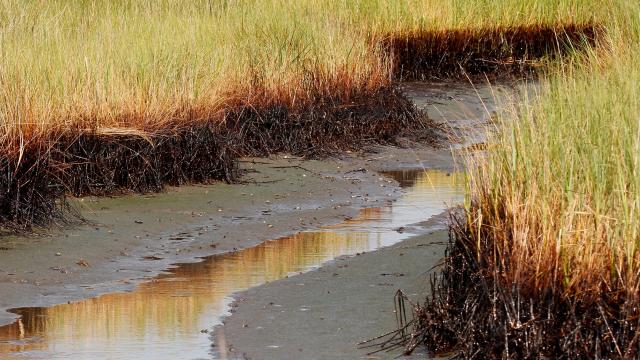Fiddler crabs build their burrows in beaches and in the muck of saltwater wetlands. Usually, those holes serve as the crabs’ home and provide each crustacean shelter and a quick escape from predators. But in some long-abandoned fiddler crab burrows along Louisiana’s Gulf coast, you’ll find something else: Residues of crude oil.
The worst oil spill in human history unfolded over 87 days in 2010. The Deepwater Horizon oil rig, leased by fossil fuel giant BP and operated by drilling contractor Transocean, exploded on April 20 about 66 km off the coast of Louisiana before capsizing and sinking two days later. Eleven workers were killed and 17 others injured in the initial rig failure. Many more cleanup workers and Gulf Coast residents were also harmed.
At its peak, the damaged underwater oil well was dumping more than 60,000 barrels of crude oil into the ocean daily, according to U.S. estimates. In total, the spill poured about 210 million gallons of crude oil into the Gulf of Mexico. Marine and coastal life suffered terribly, and tens of thousands of sea turtles, millions of fish, thousands of whales and dolphins, hundreds of thousands of birds, and untold numbers of other organisms died in the aftermath.
Though the leak was eventually capped (temporarily in July 2010 and permanently in September 2010), the spill damage and lingering effects didn’t end there. Even more than a decade later, some signs of the environmental catastrophe remain, according to a new study published in the journal Frontiers in Marine Science.
The scientists, funded in large part by the BP-established Gulf of Mexico Research Initiative, combed back through 10 years of research on the Deepwater Horizon spill. They also added in their own recent work, to construct a clearer chemical picture of what happened to all of that oil between 2010 and 2020.
They found that most of the oil degraded into byproducts (some of which are still very toxic) and dispersed in the days, weeks, and months following the spill. The largest and lightest fraction evaporated into the air. Another fraction sank through the water column and was digested and broken down by bacteria. “90% of the oil went away in a matter of months,” said Edward Overton, the study’s lead researcher and a (now retired) environmental chemist at Louisiana State University, in a phone call with Earther.
Yet 10% of the hundreds of millions of gallons of oil didn’t go away, concluded Overton and colleagues. Instead, one-tenth of the oil became water-insoluble residues, produced mainly via the chemical reaction of sunlight and petroleum. This sticky, solid fossil fuel gunk either washed ashore, entered the food web as it fell with marine snow into the deep ocean, or ended up stuck in seafloor sediments.
In coastal wetlands, which are critical and threatened habitats that provide huge benefits to people, those residues have proven especially long-lasting. “Stranded oil in marsh environments, inaccessible to mechanical cleanup equipment, retained oily mats even through 2020,” wrote the study authors in the new paper. Though the petroleum solids washed up in multiple Gulf states, lots of what ended up on beaches was able to be cleaned up a decade ago by digging and sand-sifting machines. But you can’t drive heavy machinery over a wetland, explained Overton. Which is why in Louisiana, where much of the coastline is made up of marsh not sand, the oil residue has stuck around in pockets.
These persistent residues are chemically akin to pavement or roofing tar, said Overton. “Its composition is a lot like asphalt, except that while oil was floating around, the sunlight caused a lot of the oil to make additional compounds that weren’t in the initial oil. And that makes it even more insoluble,” he explained.
Even today, “you can still go out there, if you poke around in the right spot and find the residue. So it’s not completely gone,” Overton added. But he emphasised that he thinks there’s good news too: “It’s not [still] causing a gigantic problem.”
The worst wetland effects of the spill occurred in the years immediately following. Toxins from the oil in the air and water killed lots of animals. And marsh plants coated in oil and residue died, making the land extra vulnerable to erosion. Louisiana’s usual annual rate of coastal erosion doubled in the year following the spill, even though only about 15% of the state’s wetlands were directly impacted, said Overton.
But it’s less clear what lingering effects the residue is having on the coastal ecosystem. Previous research has documented ongoing wildlife impacts from Deepwater Horizon. For example, some species’ populations have yet to bounce back from initial die-offs. Long-lived marine mammals like bottlenose dolphins that survived the spill directly still struggle to breed in the oiled areas. And at least one 2020 study concluded that Gulf fish were still being exposed to petroleum hydrocarbons. Yet there’s no research connecting the visible remaining oil residues and these effects.
Overton said it’s also not clear how much longer the residues will endure. What’s left in marshes is continuing to break up and erode away with the land itself. From there, he added, the solids will end up in estuarine sediments, where anaerobic bacteria may or may not degrade it further. “It’s probably getting broken down, but we don’t have proof of it.”
The remaining oil residues are a solid (literal and metaphorical) reminder of one of the worst environmental disasters in history. And more than a decade on, the new research is an indication of just how poorly understood the full impact of Deepwater Horizon and all oil spills are. Thankfully, the science continues on. Unfortunately, so too do preventable oil spills.
